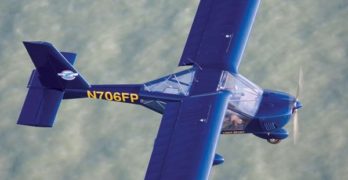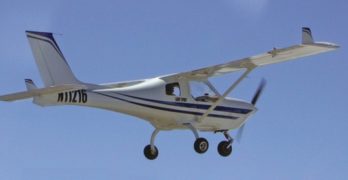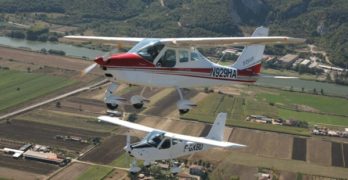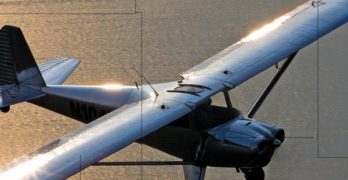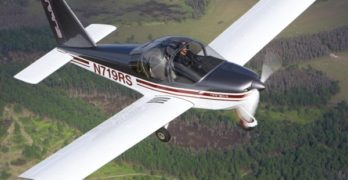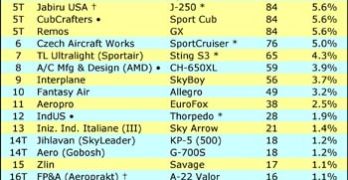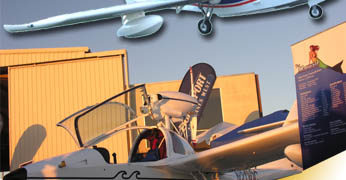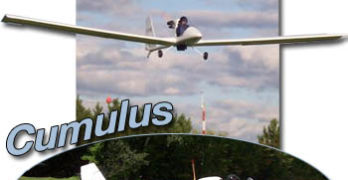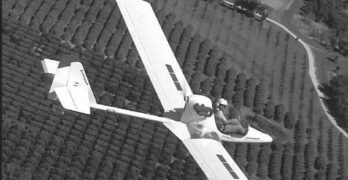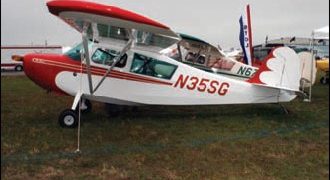Ukraine Design Meets Florida Know-How
Early in the new millennium, I took a trip to Kiev, Ukraine. My mission was to visit two companies producing
aircraft for what was to become the light-sport aircraft segment. I didn’t
know then that the A-22 I flew with designer Yuri Yakovlev would become a
U.S.-assembled special light-sport aircraft (S-LSA).
Before the fall of the Berlin Wall in 1989, Americans hardly knew Ukraine,
a large and diverse country with a rich aviation heritage that once employed
lots of skilled aviation workers and engineers building large transport aircraft
and fighters. Ukrainians spent decades toiling for the Soviet state, and
most speak Russian today despite having an indigenous Ukrainian language.
Antonov, an aerospace name Americans have come to know, had a massive
Ukraine operation under the Soviet leadership.
When the communists withdrew, tens of thousands of experienced technicians
and engineers found themselves out of work. A few ended up building
little airplanes to earn a living.
Search Results for : flight design ct
Not finding exactly what you expected? Try our advanced search option.
Select a manufacturer to go straight to all our content about that manufacturer.
Select an aircraft model to go straight to all our content about that model.
Jabiru J-170; Trainer or Recreational Flying
The Jabiru airplanes from Shelbyville, Tennessee-based Jabiru USA are funny airplanes. I don’t mean funny like a joke and I don’t mean the name sounds funny, though it may to those unfamiliar with the Australian brand. The Jabiru models are funny because from a distance they look rather small and they don’t seem to get bigger the closer you get to them.
Despite the illusion, the three Jabiru models that have earned their Special Light-Sport Aircraft (SLSA) credentials are actually quite roomy inside, even for larger American pilots. The J250 is better described as cavernous; it has perhaps the largest interior dimension of any SLSA.
The J170 is smaller, but certainly spacious enough for most occupants. A 45-inch-wide cabin is 5.5 inches wider than a Cessna 172 and it has headroom enough for all but the tallest pilots.
Based on the 2-seat Aussie kit, the J170 is aimed at flight schools.
Tecnam’s All-Metal Italian Beauties
Announced in July ’04, the Light-Sport
Aircraft (LSA) category is still relatively new, and has
yet to celebrate its fourth birthday. But many of the airplanes
getting all the attention today were not born in
the last 3 1/2 years. Many have rather long histories,
some in Europe’s microlight category and others in countries
that have applicable standards.
Among the longest in production is the Tecnam family
of airplanes. The central Italian company reports more
than 2,000 of their light planes flying in what may be the
largest fleet in this market segment. Given this company’s
track record, these airplanes have gone through
rounds of improvement. Our subject this month, the
P2002 Sierra, came from the P-96. The numbers relate to
the year of development and show the low-wing Special
Light-Sport Aircraft (SLSA) from Tecnam has a dozen
years of history.
Costruzioni Aeronautiche Tecnam (the company’s complete
name) is 57 years old and traces its roots back to
the 1950 P48B Astore.
New Old Planes — Luscombe & Champ
Luscombes and Champs
with a New Lease on Life
Pilots of the world, meet American know-how building American airframes powered by American powerplants. This month, we offer not one but two such airplanes, the Luscombe Silvaire LSA-8, and the American Champion Aircraft Champ.
These flying machines offer not only homeland availability but homeland pricing as well. Neither is subject to constant price increases from a soaring euro, and when Europe finalizes acceptance of ASTM
standards (see “Europe, EASA, and Light-Sport Aircraft” page 36), these planes may be a compelling purchase for Europeans. An LSA-8 or Champ might seem downright cheap in Europe (approximately 55,000 euros plus shipping). Globalization works in both directions!
Two-thirds of the approximately 1,270 airplanes in today’s current light-sport aircraft (LSA) fleet (as of April
2008) were built overseas, but recent entries by American companies joining the LSA parade could change those numbers. At times of rising LSA import prices and skyrocketing
fuel costs, these are two affordable aircraft Americans ought to consider.
RANS S-19; Ready for the World
The Second SLSA from RANS
RANS Inc. continues to be a significant player in the homebuilt
aircraft market as one of the nation’s largest kit airframe
producers. In the last two years, Randy Schlitter, RANS’ designer
and CEO, added manufactured, ready-to-fly special
light-sport aircraft (S-LSA) to his enterprise; the S-7LS is
presently in production, and it will be joined by the S-19LS
in 2008. The good news for EAA members interested in building
one is that the new S-19 is also available in kit form.
Manufacturing completely built aircraft under ASTM
International standards is a diff erent work eff ort than kit
manufacturing under amateur-built standards. Even so,
several industry experts agree that RANS is a good candidate
to succeed at such a multi-tasking eff ort. (Randy and
his team already simultaneously run two companies, one
for airplanes and another for recumbent bicycles.)
RANS hopes to have the S-19LS manufactured model in
production by fall 2008, for those who want to buy and fly.
2008 In Review; a Look at the Year for LSA Sales
With one month to go (and it’s hard to imagine a big December), we have figures to report for this most extraordinary year. We’re all (painfully) aware of the economic predicament, but how has this impacted light-sport aviation? Here’s my observations. *** In 11 months, the industry has increased fleet size by 35% to 1,510 fixed wing airplanes from 1,118 on January 1st. Annualizing the numbers, all airplane LSA should register 427 airplanes, which equates to about 35 aircraft per month, which means sales were about 20% off the monthly pace recorded since early 2006. *** Flight Design held its top spot and again delivered the most, but just barely. Remos has been the rising star of 2008 with a 147% increase over their total on January 1st. Tecnam became only the third company to pass 100 units registered. Other solid gains were logged by Czech Aircraft Works (up 69% in the year); Jabiru (up 53%); FPNA (up 55%, though from a lower number, which makes larger percentage gains easier); Aeropro (up 52%).
Relaunch of the Mermaid; Enter Wet Aero Inc.
Some LSA enthusiasts know of a struggle between Czech Aircraft Works and an investor group called Slavia Capital. The latter has been aggressive in their attempts to take over CZAW…unsuccessfully, thanks to the bulldog tenacity of American founder, Chip Erwin. Despite the battle, while CZAW has done well with their SportCruiser in 2008, climbing to the #8 position in overall registrations. Yet something had to give; CZAW’s amphibious Mermaid never entered production. *** Now Mermaid is returning to the market under the name Wet Aero, Inc., though you know proprietor Danny Defelici as the U.S. partner to CZAW. While the SportCruiser builder fends off the aggressor, Defelici said, “I felt it was necessary to get [Mermaid] into production.” Wet Aero has set up its own facility in Kunovice (near CZAW) in the eastern Czech Republic to manufacture the flying boat’s major aluminum sections.
Remember the Cumulus Motorglider? It’s Flying!
In the 1990s I tried my hand at developing an airplane. While that business venture didn’t make me a millionaire, it provided a valuable lesson about what it takes to stay in the light-sport airplane business. Later, I realized the project needed someone who understood building techniques better than I did. That man was Dave Ekstrom and he ultimately took over my design, the Cumulus, a motorglider. He calls his business Ultralight Soaring Aviation LLC .
In the world of soaring, a motorglider is an expensive flying machine, making it not so different than high-end LSA that cost $130,000 or more. But Ekstrom comes from the world of homebuilts and he knew he could produce a kit for a lot less if buyers were willing to pull a few rivets (about 300 total hours are needed).
One of the 21 Cumulus builders is Andre Girard of Ottawa, Canada, who kindly provided Dave with the photos you see (five Cumulus kits are now airborne).
Cumulus
Authorship Note: Although most pilot reports on ByDanJohnson are…well, by Dan Johnson, this one is not. Our great friend, Dave Higdon, created this flight review and we appreciate his willingness to let us portray it.
The article represents the Cumulus originally made by the first US Aviation, whereas today, the kit is being supplied by Ultralight Soaring Aviation LLC. [Nov. 2008]
Sailplanes, hang gliders and motorgliders suffer in “demonstration mode.” They can’t do what rivets the attention of the crowds: roaring takeoff runs that transition into steep best-angle climbs to pattern altitude before crossing the runway’s departure end.
Published in Light Sport and Ultralight Flying
True American Champ
Are you uncertain about the certification used for
LSA? Do you find imported S-LSA too expensive?
Are you struggling to accept an engine such as
Rotax, with its liquid cooling, 5500 max rpm range, and
gear-driven prop?
If you ask yourself these questions, you could choose
the Luscombe featured in this article or select the newest
entry from American Champion Aircraft, the Champ, which
sells for under $90,000, or $100,000 nicely equipped.
Like the LSA-8, the Champ is a familiar aircraft certificated under traditional federal aviation regulations.
Luscombe can boast of meeting CAR4a but, technically, it’s
certificated under ASTM standards.
As with the Luscombe, a Continental O-200 powers the
Champ. For some, this is enough to suggest a purchase. One
shortcoming is that the Champ has limited useful load, given
its empty weight of 920 pounds. Unlike an S-LSA approved under
ASTM standards (such as the LSA-8), the Champ can weigh
more than 890 pounds because American Champion continues
to build its LSA-like airplane under Part 23 certification.
- « Previous Page
- 1
- …
- 114
- 115
- 116
- 117
- 118
- …
- 145
- Next Page »


